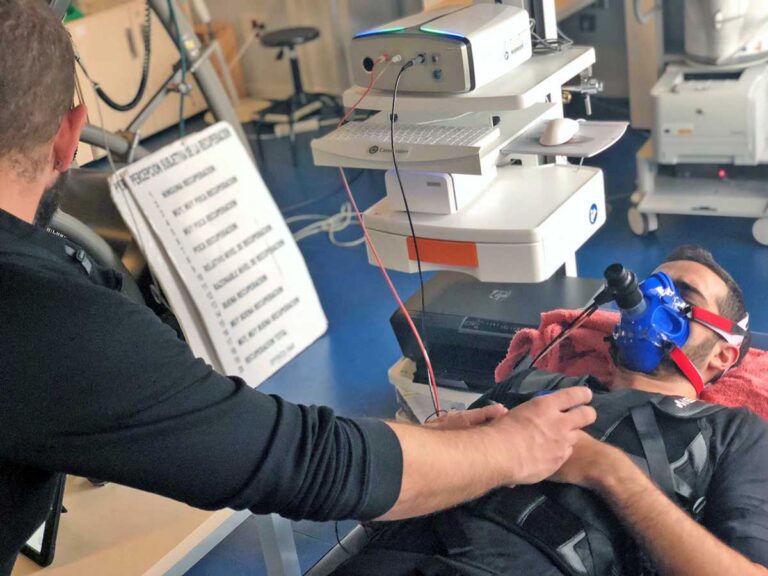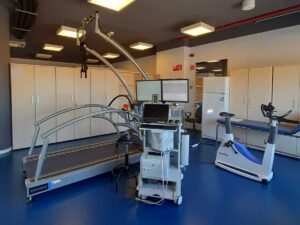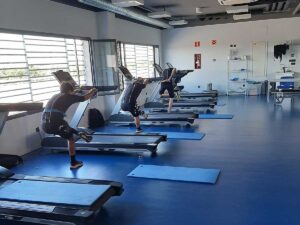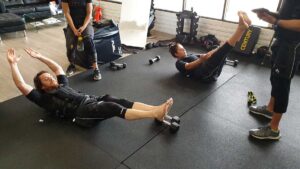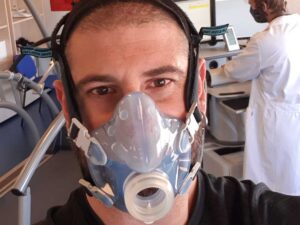Obesity is considered one of the most prevalent diseases in today’s society and its condition leads to important health problems (1). The induction of a negative energy balance (energy expenditure greater than intake) is necessary for the reduction of body weight (2).
Training with Whole Body Electromyostimulation (WB-EMS) has already been shown to have benefits on energy expenditure (3, 4), but always applying stable electrical parameters:
- (i) frequency=85Hz.
- (ii) duty cycle (50%, 4 on / 4 off).
- (iii) pulse width: 350 µsec.
- (iv) no information was provided on electrical intensity parameters (5).
On the other hand, the effects of low frequency 1-10Hz WB-EMS on energy expenditure are unknown. In addition, in previous posts we have seen how the electrostimulation suit affects muscle hypertrophy or recovery after COVID, but we do not know what the underlying physiological mechanisms are.
It is for all this that we decided to carry out a study where we compared the effect of 5 different frequencies (1 Hz, 2 Hz, 4 Hz, 6 Hz, 8 Hz and 10 Hz) on energy expenditure (kcal).
What Electrical Parameters exist, and the importance of the Electrical Frequency
Before evaluating energy expenditure in different profiles and situations, it is necessary to highlight and explain the importance of electrical frequency in this scenario.
Full body global electrostimulation is a tool that provides electrical impulses through electrodes placed on different parts of the body. These electrical impulses are defined by the combination of 4 wave parameters that determine how muscle contraction is carried out and are:
- Frequency (Hz).
- Intensity (mA).
- Pulse width (μsec).
- Work-rest time.
Frequency
Frequency is the number of electrical impulses provided per second. So 7 Hz is 7 pulses/sec and 90 Hz is 90 pulses/sec. In the first place, and by way of synthesis, we could say that low frequencies have a priority for the recruitment of slow fibers, while higher frequencies have a preference for the recruitment of fast fibers. That is why, depending on our goal as coaches and the type of exercise we are doing, it is convenient to use one type of frequency and another.
Intensity
Intensity is the amount of energy that ends up reaching the body. Muscle contraction, whether at low frequency or high frequency, is determined by intensity. The higher the electrical intensity, the greater the muscle contraction. In this case, the mA will always range from 0-100mA.
Pulse width
The pulse width is the time that the electrical impulse lasts. It is measured in μsec because it is a very short time, and more so when high frequencies are used. In the case of the electrostimulation vest, the pulse width varies between muscles, since some muscles require a greater pulse width to achieve the expected contraction, and others require a shorter impulse time.
Work-rest time
Finally, work-rest time is the relationship between the time under tension caused by electrostimulation and the rest time.
In the study that we are discussing today we will have a work-rest time of 59:1, which means that the study participants were under electrical intensity for 59 seconds with one second of rest.
Once the electrical parameters are introduced, we have to understand that the frequency has a direct effect on the usefulness of the WB-EMS and, therefore, it is crucial to understand what happens within the range of frequencies that exist. In order to find out, we wanted to see the isolated effect of WB-EMS on healthy young adults who performed two tests:
- i) passively lying on a stretcher with electrostimulation in place.
- ii) during a low-moderate intensity exercise with the electrostimulation suit.
Study Electrostimulation and Energy Expenditure at rest and in activity
First, the analysis of the energy expenditure that each participant had at rest was carried out. For this, an indirect calorimetry analysis was performed using a mask with the Vyntux CPX device. Next, the participants put on the Wiemspro electrostimulation suit, and passed randomly and counterbalanced through the 5 commented frequencies.
The electrostimulation protocol lasted 2 minutes, calibrating the intensity to the highest tolerance of the individual, and 4 minutes of electrical intensity without rest. Once these 6 minutes had passed, the participants rested for 10 minutes on the stretcher until the application of the next frequency. Both HR and gas production and consumption data were taken at all times.
Secondly, and after 7 days of rest, the participants went through the same electrostimulation protocol again, but performing a moderate-low intensity treadmill exercise.
The two training sessions had an average duration of 1 hour 30 minutes and the pulse width, intensity and work-rest time remained stable during both tests; only the electrical frequency used changed:
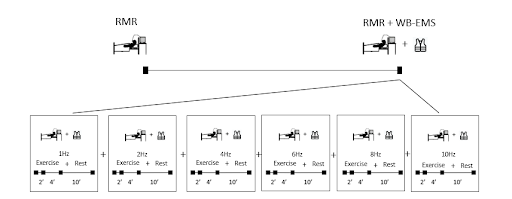
Imagen 1 Organization of day 1

Study Results
After applying the previously mentioned frequencies, we found the increase in energy expenditure (measured in kcal/min) in each of the different frequencies and at the same self-perceived intensity of the participant. All participants were at the maximum tolerable intensity before the pain.
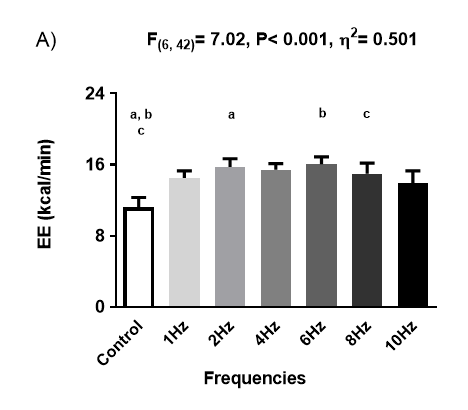
Graph number 1 shows the comparison in energy expenditure at rest and for each of the commented frequencies. It should be noted that the greatest increase in energy expenditure occurs at 4 Hz, although it seems that any type of frequency increases energy expenditure significantly above baseline values.
“Electrostimulation promotes greater energy expenditure in resting conditions”.
“Without doing anything we would “burn” approximately 270 kcal”.
That is, electrostimulation favors greater energy expenditure in resting conditions. If we multiply the increase in kcal/min by a certain time (30 minutes) we see that at 4 Hz and without doing anything we “wanted” approximately 270 kcal.
On the other hand, it seems that when we exercise, the increase in energy expenditure produced by WB-EMS is not as great, and there are not as many differences as can be seen in graph 2.
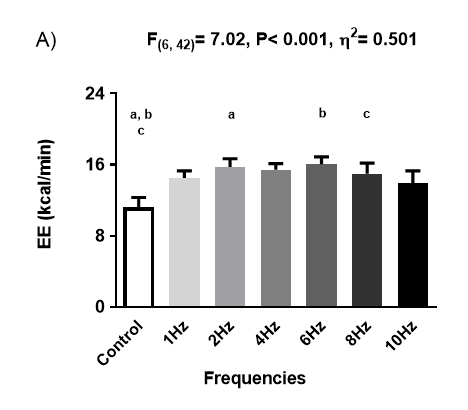
As we can see, the only differences that we can appreciate are at 2 Hz, 6 Hz and 8 Hz, although as we see in the graph they are not extraordinary. This difference may be due to the fact that there are 3 muscle groups that are the quadriceps, the hamstrings and the gluteus that did not allow a high intensity due to the compromise that can occur in walking.
What does Electrostimulation contribute to Energy Expenditure?
As we have previously mentioned, the WB-EMS has 4 electrical variables that, related to each other, offer one response in the body or another.
In this case, we have manipulated the low frequencies in order to see if there are differences in energy expenditure and we have verified that, in situations of passivity, that is, when a person is lying in bed, the application of electrostimulation It is a valid tool for increasing energy expenditure. 4 Hz being the ideal frequency for increasing energy expenditure.
Conclusion
The electrical frequency is a variable under study. In the project carried out in the Wiems Lab, we were able to verify that depending on the selected frequency, the physiological response will be one or the other. WB-EMS therefore has an effect on energy expenditure in healthy young men.
Global whole body electrostimulation is an effective tool to increase energy expenditure at rest and during exercise.
Unai Adrian Perez de Arrilucea
Wiems Lab Team

